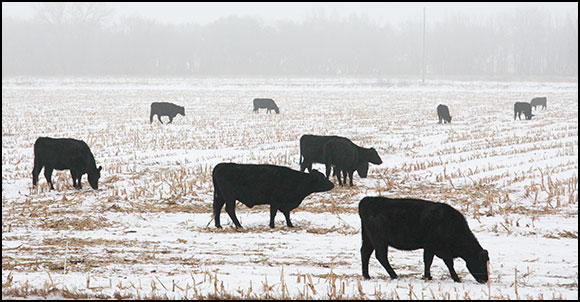
Year-round Grazing Using Standing Corn for Winter Feed
Researchers prove raising cattle with little to no hay can be done in the West.
Research at Utah State University (USU) a few years ago looked into a year-round grazing system. Randy Wiedmeier, now a University of Missouri Extension livestock specialist, spent 25 years at USU working on range and forage projects. One project focused on using field corn to provide winter grazing after grazing irrigated pasture during the summer and fall.
“We started grazing silage-type corn in the winter and were very successful. For three years in a row we had a group of cows that never received any hay,” he says.
This was a huge accomplishment because in Utah’s climate, cattle have to be fed for many months during winter. The corn stands above the snow, and Cache Valley gets a lot of snow.
“If you are using irrigated ground for pasturing cattle, there would be a lot of reason to do this, even as far north as Montana. When I was going to Montana State University at Bozeman, they were growing silage corn there without much trouble. In our experiment in Utah, due to the fact there was so much dry matter and energy yield on those corn plants, the carrying capacity was unbelievable. It took only 0.0014 acres per cow per day. On an acre, we were able to carry a cow and her calf on a 365-day basis, and we did this for three years,” says Wiedmeier.
“Adjusting those figures to what they would be today on that system — grazing irrigated pasture for 180 days through the growing season and then grazing standing corn through winter — it would cost about $360 (feed costs) per cow-calf pair per year,” he adds. “Then if we add the non-feed costs, such as labor and everything else associated with keeping the cow for a year, it might be about $300. So our total annual cow cost could be about $650, which is extremely high compared to what it was a few decades ago.”
With an intensive system like this, Wiedmeier and his team were able to sustain a 95% or higher weaning average and could easily wean a 700-pound (lb.) calf in 220 days.
Calves raised on irrigated pasture are always heavier than calves out on dry rangeland, partly because the dams milk better.
“One year we put some fall-calving cow-calf pairs out on that standing corn and they did very well, too. So if we have a $650 cow cost, a 700-lb. calf and a weaning percentage of 95%, this puts us around a breakeven price of $1.00 per pound per calf. So the producer would need about $700 per calf to break even,” he says.
“If you are able to carry a cow on one acre, you are making a decent per-acre, per-year profit. This might be more profitable than putting up hay on that same acre.”
It may also be a feasible option if a person’s public grazing is eliminated or reduced, and you have to manage the cattle at home on your hayfields instead of putting up hay.
“The most interesting thing was grazing corn. That happened by accident because one of the Ag Experiment Station farm crew left our irrigation dam in place. The corn got flooded and they couldn’t harvest it. They asked me if I wanted to graze it. We strip-grazed it using poly wire; we couldn’t give the cows total access because the corn was fully eared (very energy-dense). This worked beautifully, grazing the cattle systematically through that corn patch,” he says.

Editor’s Note: Heather Smith Thomas is a freelance writer and a cattlewoman from Salmon, Idaho.






